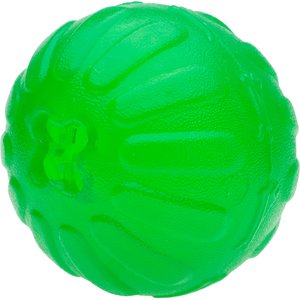My dogs are barkers. They’ve declared themselves neighborhood patrol, so they bark when other dogs start barking, when they hear people outside chatting, or even when a car door slams.
I’m a dog trainer, and I also strive to be a responsible pet parent, which means I don’t want my dogs to annoy my neighbors. But how do you get a dog to stop barking? First, you need to identify why they are barking. Read on for tips on how to train a dog to stop barking.
Why Dogs Bark
Barking, like whining, growling, and howling, is a dog’s natural form of communication. Dogs might bark when they feel threatened, when they want to play, when they need attention, or to signal danger.
Genetics can also play a part in your dog’s likelihood to bark. Some breeds are more prone to barking, like Beagles and Terriers.
What Causes Problem Barking
Attention seeking/demand
Barking to get resources like your attention, food, toys, or access to the outdoors.
Territorial
A response to someone or something entering a dog’s perceived turf.
Play barking
The excitement of having fun with your canine friends can tip over into barking.
Alarm
A response to a startle, like a sudden unexpected noise.
Boredom
Dogs who are unexercised or under-stimulated will bark to self-soothe or stay "busy."
Fear
Fear barks sound scary but are an attempt to maintain or increase distance from something frightening.
Excitement
Triggered by enthusiasm for activities, like mealtimes, play, or going for a ride in the car.
Separation intolerance
Short-term frustration barking to signal discomfort at being left alone. (This reaction is not separation anxiety, which typically also includes more extreme behaviors like pacing, panting, drooling, destruction, and potty accidents, and might begin before the parent even leaves the house.)
How To Get Your Dog To Stop Barking
Because there’s no single reason for barking, there’s no “one size fits all” approach to treating it. The following suggestions are a mix of simple management solutions, which can be implemented on the fly, as well as training recommendations, which require ongoing practice to train a dog not to bark. To train puppies not to bark, here are 5 helpful tips.
Block Your Dog’s View

Management solution: helpful for alarm barkers and territorial barkers.
If your dog reacts to activity they see outside, simply change their vantage point:
- Close the blinds during high-traffic times or use temporary stick-on opaque privacy film.
- Place the window film a few inches above your dog’s line of sight, then gradually lower it down inch by inch over the course of several weeks, before removing it completely.
Provide Busy Toys

Management solution: helpful for attention seeking/demand barkers, boredom barkers, and separation distress barkers.
Boredom barkers and separation distress barkers can benefit from staying occupied with hard rubber toys that dispense treats. Treat-dispensing toys can also help with attention-seeking barkers who react when you’re on the phone or computer.
Turn on a White Noise Machine

Management solution: helpful for alarm barkers and territorial barkers.
A white noise machine’s steady unchanging sound can help mask possible alarm barker triggers, like garbage trucks and other dogs barking. (I’ve used a white noise machine with my dogs for years and it stops them from barking almost immediately!)
Try a Pheromone-based Treatment

Management solution: helpful for fear barkers and separation distress barkers.
Plug-in diffusers that mimic the “calming chemicals” given off by female dogs can help to soothe dogs who bark due to stress. While you might not see a dramatic shift in behavior—keep in mind that plug-in treatments aren’t prescription strength—diffusers are an easy way to help make a scary scenario feel more secure.
Teach “Hush”

Training solution: helpful for territorial barkers and alarm barkers, as well as some excitement and play barkers.
Teaching “hush” can short-circuit a dedicated barker.
Follow these simple steps to help train your dog to stop barking:
- Walk up to your dog while they're barking with a high-value treat in your fist.
- Place your hand in front of their nose so that they can smell the treat but can’t get to it.
- Your dog will likely stop barking to sniff the goody. Once they're quiet, say “hush” (you’re “naming” the silence).
- Toss the treat a few steps away from your dog.
- Repeat the process until you can just say “hush”’ without needing the hand prompt in front of your dog's nose, and then give them a treat.
- Gradually ask your dog to do more in order to get the treat, like coming to you and waiting quietly. (This is the technique that I’ve used with my dogs, and they often police themselves; if one dog barks, the other runs to me to get a treat for remaining quiet.)
Ignore the Barking

Management and training solution: helpful for attention-seeking barking, play barking, excitement barking, and frustration barking.
What’s the secret ingredient that many barkers want? Your attention! Barkers who are trying to get a reaction from you, whether it’s to get you to throw the ball or hurry up and serve dinner, are looking for some sort of acknowledgement from you when they bark.
You can help your dog understand that barking doesn’t work. By doing the opposite of what your dog wants when they bark, you can train your dog to stop barking for attention:
- Turn away, walk out of the room, drop the ball, or put the leash down.
- Wait for a moment of quiet or calm behavior from your dog.
- Once your dog has calmed, then pay attention to them.
With consistency, your dog will bark less because they understand that quiet works and barking doesn’t.
Add More Exercise

Management and training solution: helpful for all barkers.
Nearly every dog can benefit from more exercise, both mental and physical. A dog who has had a good workout will be less likely to be on alert for perceived interlopers or feel the need to pester you for attention.
Take the time to wear your dog out every day with a game of fetch or tug, and get their brain activated by introducing mind-teasers like “find the toy” and hide-and-seek. Remember, a tired dog is a quiet dog!
Get more dog training tips:
Share:


















